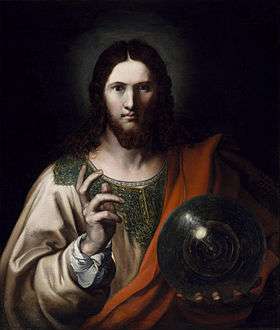Salvator Mundi (Leonardo)
_Salvator_Mundi_circa_1500.jpg) | |
| Artist | Leonardo da Vinci |
|---|---|
| Year | c. 1490–1519 |
| Type | Oil on walnut |
| Dimensions | 45.4 cm × 65.6 cm (25.8 in × 17.9 in) |
| Location | Private collection, New York City |
Salvator Mundi is a painting of Christ as Salvator Mundi (Savior of the World) recently attributed to Leonardo da Vinci, who is known to have painted the subject. It was lost and later rediscovered, and restored and exhibited in 2011. The painting shows Christ, in Renaissance garb, giving a benediction with his raised right hand and crossed fingers while holding a crystal sphere in his left hand.
History
In France, Leonardo da Vinci painted the subject, Jesus Christ, for Louis XII of France between 1506 and 1513. The recently authenticated work was once owned by Charles I of England and recorded in his art collection in 1649 before being auctioned by the son of the Duke of Buckingham and Normanby in 1763. It next appeared in 1900, when it was purchased by a British collector, Francis Cook, 1st Viscount of Monserrate. The painting was damaged from previous restoration attempts, and its authorship unclear. Cook's descendants sold it at auction in 1958 for £45.
In 2005, the painting was acquired by a consortium of art dealers that included Robert Simon, a specialist in Old Masters. It was heavily overpainted so that it looked like a copy, and was described as “a wreck, dark and gloomy”.[1] It was then restored and authenticated as a painting by Leonardo. It was exhibited by London's National Gallery during the Leonardo da Vinci: Painter at the Court of Milan from 9 November 2011 to 5 February 2012.[1][2][3] In 2013 the painting was sold to Russian collector Dmitry Rybolovlev for $127.5 million, via the Swiss dealer Yves Bouvier.[4][5][6]
Attribution
The painting was compared with, and found superior to, twenty other versions of the Salvator Mundi. There are several features in the painting which have led to the positive attribution: There are a number of pentimenti evident, and the unusual technique of pressing down the side of a palm into the paint is typical of many Leonardo works.[7] The way the ringlets of hair and the knotwork across the stole have been handled are also seen as indicative of Leonardo's style. Furthermore, the pigments and the walnut panel upon which the work was executed are consistent with other Leonardo paintings.[8]
Leonardo expert Martin Kemp, who helped authenticate the work, said that he knew immediately upon first viewing the restored painting that it was the work of Leonardo: "It had that kind of presence that Leonardos have ... that uncanny strangeness that the later Leonardo paintings manifest."[7]
Copies of Leonardo's work

 Copy by member of Leonardo's school
Copy by member of Leonardo's school_cropped.jpg) Etching by Wenceslaus Hollar (1607-1677)
Etching by Wenceslaus Hollar (1607-1677) Copy by unknown Flemish artist (c. 1750-75)
Copy by unknown Flemish artist (c. 1750-75)
Notes
- 1 2 Esterow, Milton (June 2011). "A Long Lost Leonardo". ARTnews. ARTnews. Retrieved 2011-06-30.
- ↑ BBC News (12 July 2011). "Lost Leonardo Da Vinci painting to go on show". BBC. Retrieved 2011-07-12.
- ↑ "Scholars authenticate a painting that was missing for centuries". En.99ys.com. Retrieved 2013-07-22.
- ↑ Reyburn, Scott. Recently Attributed Leonardo Painting Was Sold Privately for Over $75 Million. New York Times. 3 March 2014.
- ↑ Grosvenor, Bendor. "Salvator Mundi at heart of art fraud case". arthistory.com. Bendor Grosvenor. Retrieved 12 March 2015.
- ↑ Clémençon, Gilles. Accusé d’escroquerie, le "roi des ports francs" Yves Bouvier riposte. RTS Info. 22 March 2015.
- 1 2 Goldstein, Andrew M. (17 November 2011). "The Male "Mona Lisa"?: Art Historian Martin Kemp on Leonardo da Vinci's Mysterious "Salvator Mundi"". Blouin Artinfo.
- ↑ http://arthistory.about.com/od/leonardo/ss/A-Closer-Look-at-Salvator-Mundi-by-Leonardo.htm
External links
| Wikimedia Commons has media related to Salvator Mundi by Leonardo Da Vinci. |
- Original press release from Robert Simon
- Platonic receptacles, Leonardo and the Salvator Mundi, iconographic and provenance details of the painting